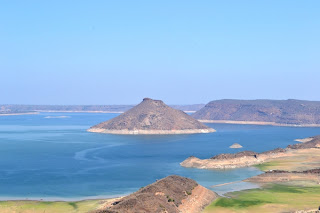 |
| Yelleswaragattu |
The boat ride to the island, Yelleswaragattu is an absolute joy! On one hand as the retreating shore offers a pleasant view, we are surrounded by an even better one. A hundred fishes joyfully play in the water, jumping with the breaking waves. The sunlight reflects and they sparkle in the sun.
We are at Yelleswaragattu as the night falls. The water hums a gentle lap lap-lapping song while the stars shine bright above. The milky way runs across the sky, and there is no moon, making the stars shine even brighter. The fishes are a little bolder and come right up to the shore. We can see them and the crabs playing around, under the torchlight, when we go to wash our utensils.
The camping site was supposed to be the peak of the island, but the monkeys on top foil our plan. We settle for a flat land midway. The ascend, in spite of having steps carved out, is pretty exhausting. The small pathway to the camp is pretty easy to miss. All the trees are full of spiders, and when we wake up in the morning, they haven’t spared the tents either. Throughout the night, they have been busy building webs on the trees and on the top of our tents.
The morning offers a tough competition to the night. The sun rises from behind the hills, giving a beautiful highlight to the gentle waves. There seems to be an endless blue around, interrupted only by hills and islands. A few fishermen are out with their nets and coracles, hoping for an early morning’s catch. It takes us a while to realize that, they look like birds from the distance.
 |
| Shiva Temple |
We decide to take the alternate route through the Anupu village while returning. The boat ferries us to the mainland, straight onto where the tour for the Nagarjunkonda starts. There are a lot of people here, but surprisingly, we see no transport. We talk to the locals to arrange a vehicle for us, and while waiting, we come across a beautiful garden, well maintained with facilities for tourists to rest, and a structure, we debate for some time, what it could be.
It is the reconstruction of the Acharya Nagarjuna University, built in the 3rd-4th century A.D. The original site was unearthed in a village nearby, but once the construction of the Nagarjuna Sagar Dam would be over, in 1958, it would submerge 54 villages, and take along with it the beautiful architectures of the university, which stood 3 storey’s tall. The archeologists, move the original bricks and columns, and reconstruct the model here. The reconstruction model has replica of the classrooms, open air auditorium, waiting rooms, stupas, Chaitygriha, meditation rooms and even toilets!
Not only is it a place of historical significance, there is a lot of biodiversity too. Placed amidst a dry and mostly barren land, the garden stands like an oasis, beautifully green and with lots of flowers. Birds and butterflies flock around. We see blue tailed parakeets, red vented myna and hoopoe, among many others.
And as all good things must come to an end, and so should this trip, our auto arrives. We return back to our routine lives with the honking of the vehicles replacing the song of the nature, the stars replaced by the city smog, and the peace replaced by the slogging at work. But only, till next time!
Distance from Hyderabad:About 200kms from Hyderabad, connected by road
How we reached: We took a bus to Devara Konda village, and from there to Kambalapally. 1 bus runs up and down from Kambalapally, 3 times every day. One can easily expect a delay on about an hour. Devarakonda to Kambalapally is about 70kms and takes about 2 and half hours.While coming back, we took an 8-seater auto from Anupu to Macherla, some 30 kms. From Macherla, buses ply frequently to Hyderabad.
Best Season to visit: In monsoon, the water might be above danger level, and it might be risky to visit Yelleswaragattu. Summers would be too hot, as there is no green cover. All other seasons are great!
Food and Restaurants: There is no restaurant at Kambalapally, we packed from Devarakonda which has a few small eateries. At Kambalapally, we bought fish from the local fisherman and cooked our own barbeque along with rice that we had brought along with us. However, there is one small grocery shop where one can get vegetables, fruits and other grocery stuff.
A million thanks to GHAC for organizing exploratory trek to mysterious Island - Yelleswaragattu.
Article written by Lipika halder and Adventurer Ram Raj was explored the Island.
Blog Link: http://islandinnagarjunasagar.blogspot.in/

1 comment:
Are you searching for trekking in India? If you looking for trekking in Bengaluru, then check our website for Trekking Groups in Bangalore.
Post a Comment